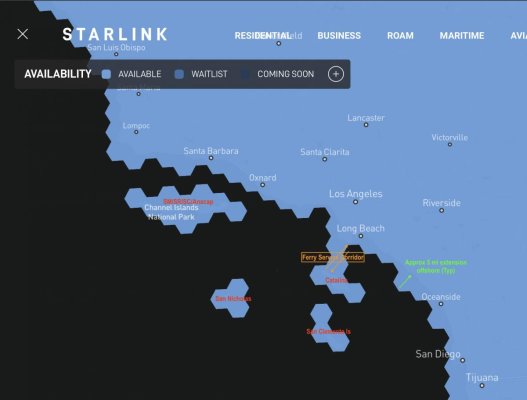IridiumGO Exec was recently introduced that claims 40x faster than standard IridiumGO, which makes it 22kbps up/88kbps down. And its still pretty expensive
https://satellitephonestore.com/catalog/sale/details/iridium-go-exec
Compared to Starlink you get:
- 1,000,000 times less data allowed for the same monthly rate
- 1,000 times slower
- 3x the equipment cost
- 1 year commitment vs 1 monthly.
- Only really works with specialized, dedicated apps, not generic internet services.
The only reason I can see that you would even consider this is if it's REALLY important to you to have 1) fringe incremental coverage, and/or 2) a bit more portable. And it's a big price to pay for those couple of things. So I think their addressable market went from "every boat, RV, or hiker who goes outside of cell coverage", to "only people who go outside of Starlink coverage, or need greater portability (e.g. hikers). I'll bet sales have dropped by 10x to 100x.
As for geo-stationary satellite comms, well, that will remain expensive and usage based with low data caps. If history serves (telco being Exhibit #1; cable tv being #2), they will enforce contractual lock-ups and milk an ever-shrinking customer pool. If you've never read "The Innovators Dilemma," predicts the cyclye pretty well. In short, once you have a profitable business, it's difficult to justify investments in disruptive technology that will cannabilize your base. It partially explains why DJIA companies listed in 1950 are mostly no longer DJIA listed today (Kodak, ASARCO, Sears, Woolworth, International Harvestor, etc.). Law of the jungle....
Peter
Agreed, however I would argue that the Telco industry has done a pretty good job reinventing itself. Two of the local operating companies (Baby Bells) have emerged as Verizon and ATT, riding the switch over to cellular and mostly shedding land lines. And they have transitioned from annual contracts, low data caps, and call rates by the minute, to unlimited calling, increasingly including international calling, unlimited data, portability, etc. I think one of the their big failings has been universal coverage, and I think that's more a failing of regulators. Where I live, there STILL isn't cell service, for example. And past federal funding to create universal coverage has all just disappeared into the swill pile with no increase in coverage, at all. This is an age-old problem with utilities where the most profitable approach is to cherry pick locations where you can make the most $$ and pass over the unprofitable locations. But that fails to serve the public need or public objective.
When cable first started to be deployed, some states were smart and only licensed providers on the condition that they served EVERYONE equally. I lived for a long time in a pretty rural part of a pretty rural town, but we got cable at the same time as the rest of the town. Where I live now, they didn't impose that requirement, so cable runs along the main highway (a rural kind of highway, not an interstate highway), has branches to populated pools of houses, and that's it. Those of us further off the beaten path and not clustered with other houses don't have it, and never will. It will simply never happen at this point.
Oh, and I don't think Verizon and ATT have the changes they have "voluntarily". They would still be charging for every minute, every MB, with locked in contracts if they could. It has all evolved and changed because of competition. Companies like T-Mobile have broken the business model as part of trying to win customers, and that has forced the behemoths to adapt. Slowly, but surely.
So will the ViaSat and VSat companies become Verizon or ATT, or will they become Kodak or Sears? Right now my money would be on Kodak and Sears, but you never know.

